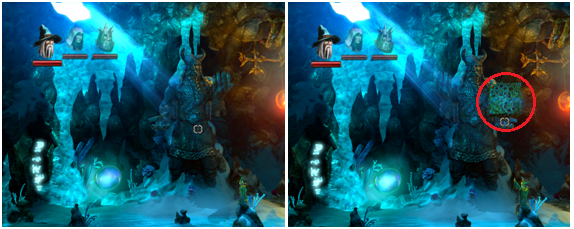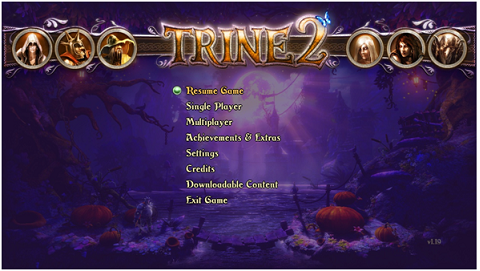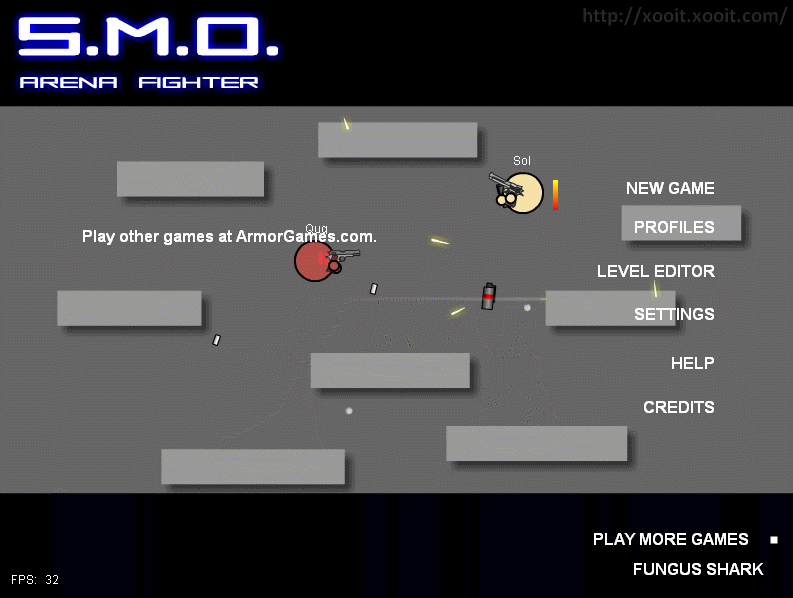Trine 2 Official Trailer: http://youtu.be/t-wzG14VZd0
Introduction
Trine 2 is a side-scrolling platform game that focuses on solving puzzles to complete each level. The story revolves around 3 heroes, a wizard, a knight and a thief, who wants to save their world from danger. Players can choose to control any one hero at any time to solve the puzzle. Each hero has unique abilities which provide a wide variety of game play scenarios.
Lens 24: Action

- Innovative way of controlling actions of 3 different characters. The wizard is able to draw boxes and planks to summon them. Players can use the objects to cross obstacles or as a ladder to reach certain areas. The thief can shoot arrows and hang/swing on platforms. The warrior can break rocks and block projectiles.
- Attack enemies in multiple ways. For example, trapping the enemy in boxes drawn by the wizard, swinging a sword, or freezing it with an arrow. This provides a diverse range of actions that can interact with the environment or enemy.
With 3 different characters, players control a wide range of actions that can be applied to different puzzles. Each action is accompanied by beautiful graphics which enhances the player’s experience. It also creates a high level of interactivity as player’s have the option to play with the environment while thinking about how to solve a puzzle.
Lens 6: Problem Solving

- Robust physics engine used to solve puzzles. For example, dropping a box to shift the hands of a statue unlocks certain mechanics.
- Different characters have different abilities to be used in different scenario. This creates many solutions to a particular puzzle which allows more room for creativity
- Objects are also provided to create greater diversity in puzzle solving
- Secret paths require exploration and provides rewards for the player
- Harder puzzles build upon previous knowledge of solving an easier puzzle
As a puzzle game, Trine 2 has designed a wide variety of puzzles to challenge players. By controlling characters with different abilities, players have a wide range of tools available to solve a particular puzzle. This allows players to explore different ways to solve each puzzle. In addition, players will not feel restrained as they have freedom of control over their play style. However, the puzzles in Trine 2 are static and do not have replay values. It follows a story progression and once the game ends, most players will not be motivated to play it again.
Lens 35: Heads and Hands

- Contains elements of hack and slash by killing enemies which adds a new variety to reduce the stress on the brain from puzzle solving
- Fighting style is simple and fun to play. It involves fighting enemies while solving puzzles.
- Must move fast to dodge projectiles as well. This requires proper timing before jumping across some obstacles.
- Using both dexterity and brains creates a good balance in player experience
Apart from puzzle solving, the game also requires good hand eye coordination. To reduce the draining effects of puzzle solving games, fighting and dodging mechanics were cleverly included. These mechanics complement the story and engages the player.
Lens 31: Challenge

- Challenged to solve puzzles with the given tools. For example, the picture shows a solution to climb up a cliff. Use the wizard to create a box to ride up the steam. To defend against the fire, switch and use a warrior’s shield.
- Players are challenged to switch characters to adapt to the situation
- Wide variety of different puzzles provides a different challenge. Difficulty of puzzles increases as the game progresses
- Difficult challenges occur when a boss appears. Increases the tension of the game and creates a greater sense of satisfaction after defeating the boss
Challenges are consistent throughout the game to create tension. They are also challenged to balance both puzzle solving abilities with fighting skills that are required during some parts of the game. The game design ensures that players will not feel bored while playing the game.
Lens 37: Cooperation

- Players can play with up to 2 friends to enjoy the full experience of the game
- Very special cooperation mechanism where player can swap character control depending on the situation
- Multiple character are controlled when in cooperation mode which creates more options to solve the problem
- Game experience is enhanced as teamwork will create new opportunities to explore new places
- Synergy between players when they work together allows them to complete each challenge faster
Trine 2 truly shines when there are 3 players in the game. In single player mode, players can only control one character at each time. However, when multiple characters are controlled, abilities can be used simultaneously. This allows infinitely many strategic team plays to solve puzzles. Players will feel motivated when they discover a new way to perform a specific action.
Conclusion
Trine 2 creates a fantasy world that provides player with a high degree of freedom. They choose from 3 unique characters and decide how to use them to solve a wide variety of puzzles. It is delightfully open-ended as there are many ways to solve a puzzle. Although it loses out in replay value, it makes up by providing players with an unforgettable experience in this magical world.


